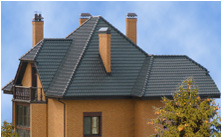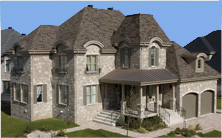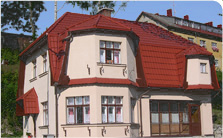Modern systems of natural lighting
Transportation of the world: modern systems of natural lighting
Natural light is necessary for people, it increases the comfort of the environment, health, efficiency and productivity of each person. That's why SNiP 23-05-95 * "Natural and artificial lighting" requires a normative amount of natural light in rooms with a permanent presence of people. In exceptional cases, a lack or absence of natural light, subject to compensate for this deficiency a significant increase in normalized values of illumination from artificial light sources, which leads to a sharp increase in energy consumption.
Under side illumination using standard lighting aperture is used only scattered component of light from the sky (direct solar radiation along with the highest positive impact leads to glare and uneven lighting, increased heating of the premises). In this case, an exponential decay with distance from the light side lighting aperture, which in large buildings (buildings "deep-") requires a constant included artificial lighting in remote areas away from windows (for example, in typical industrial buildings 60 m wide and more even glazing around the perimeter of the central zone width of 40 m is not getting enough natural light).
The situation is greatly complicated in besfonarnyh buildings where technological conditions required to maintain a constant temperature or the total absence of dust and moisture. For side lighting in the city more negative role played by the screening of lighting aperture surrounding buildings and structures.
Application of top-lighting (rooflights, shedovye coating) can be effective only in the single-story buildings, but in these cases the direct solar radiation are wasted, and heat transfer through the lighting aperture is too large and requires, as in previous cases, the high cost of heating the illuminated rooms in winter and cool in summer.
Standard heat loss in single glazing up 5.6 W / sq. m * K. When you use the most advanced triple-pane windows with argon-filled (triple glazing) with the space between the panes of 16 mm, they are 1.9 W / sq. m * K, ie through the lighting aperture area of 1 square. m lost 1.9 W of thermal energy for each degree temperature difference inside and outside the premises. But lighting aperture area are 2-3 times more. Coefficient of solar teplopostupleny with single glazing is 5.6 W / sq. m * K, while the double glazing with argon filled - 0,3 W / sq. m * K.
Many public and industrial buildings 60-70% of the heat removal which employs air-conditioning systems consume a significant amount of electricity is brought into the room is artificial lighting.
Incorporating all these circumstances requires a comprehensive solution of the engineering of lighting systems, air conditioning and heating to reduce the cost of construction and operation of buildings. How could deliver natural light, including direct solar radiation in the central parts of buildings, in areas remote from the side lighting aperture, a sunken room in termokonstantnye shop without disturbing the thermal regime? You must use the new technology of natural light through the hollow fibers (Fig. 1 and 2).
Lighting systems with hollow tubular skylights were first used in the early 90's. Twentieth century. in Australia, and then - in the U.S. and Canada. The most widely used new technology in recent years - after the serial production of optical fibers in Italy and the UK. Currently, the Technical Committee TS3.38 CIE prepares an official report on these systems.
System with hollow tubular skylights consist of three main components: svetoprinimayuschego, transporting lights and svetopereraspredelyayuschego (light-scattering). Light-receiving device in the form of a transparent dome located outside the building on the roof or the facade (Fig. 3), and may contain a special optical element that receives a live stream from the sun and diffuse sky light from the entire hemisphere (when installed on the roof), while working for a refractor the northern side of light and a reflector to direct light south. This element is an "optical funnel" that fills the optical fiber with natural light. The dome is installed on the roof with a special device in the form of "cup" that integrates the components of the dome in the roof and prevents the ingress of moisture.
Transporting light unit - a set of aluminum tubes abutting straight or articulated forms (Fig. 4), with inside polymeric multilayer coating with a reflection coefficient over 0.99. The light from the light-receiving device extends along the optical fiber based on multiple reflections, and enters the room lighted by light scattering unit or diffuser. Pipe diameters fibers 250-375-530-650-900 mm. Knee provide rotation from 0 to 30 °, from 0 to 60 ° and from 0 to 90 °.
The diffuser can be different sizes, shapes (round and square) and from a variety of materials, but usually has a light-diffusing surface and neslepyaschuyu brightness. Fiber optics can be equipped with additional devices:
• lamp evening / night lighting, exhaust fan • the soft limit of the light beam with a remote control.
The predominant part of the territory of Central Russia during the whole year level has a large outdoor natural light. In the summer, when the sun, it reaches 100 klx. At the latitude of Moscow, more than 500 lux illumination on the surface of the earth is more than 4500 hours per year, with 60% of the time - more than 12,5 klx, and 40% of the time - more than 24.5 klx. In such circumstances, the hollow tubular skylights can provide enough natural light to the required floor space.
Natural lighting facilities provided by hollow optical fiber
The results showed that even a single optical fiber is enough for many of the subsidiary and premises with a temporary stay of people. When using the optical fiber lighting system in many large-diameter (600 mm) can be obtained relatively high levels of total daylight. It should be noted that due to tightness of the inner cavity of the optical fibers, and slight convection heat transfer in this cavity heat transfer coefficient of optical fibers is very small (for the fiber diameter of 250 mm - 0,2 W / K).
For clear-sky (100 klx) through a light is lost at approximately 3 times less heat than a lighting aperture (at the same level of luminous flux). Even under cloudy conditions (25 klx) through a light is lost in 1,5 times less heat than a lighting aperture.
The reason for the differences in the efficiency of lighting aperture, and the optical fiber lies in the fact that the fiber can collect both direct sunlight and diffuse sky light. Lighting aperture, usually only pass the last component, if it is not specifically oriented to the south. In this case there are problems glare and excessive insolation, windows TONE or install blinds, thereby reducing the light transmitting capabilities. Finally, as already noted, the vertical lighting aperture light falls from a smaller area of sky than on the input device of the fiber (if no additional constraints).
Depending on the fiber parameters (length, diameter, number of knees), seasons and sky and the rate of natural light when working fibers can be from 0,7 to 2,5.
Improving the conditions of natural light and well-being of people with systems of hollow tubular skylights do not require large investments (substantially less than 1% of construction costs), and fully pays for itself through energy savings over one to two years.
It is extremely important to the widespread use of systems with hollow optical fibers in new and renovated buildings to improve the livelihoods and savings of energy consumption.
Source: Julian Aizenberg, Ph.D., professor, academician of the Russian Federation Economic News Agency, the director of the Moscow House of Light, editor in chief of "Lighting", Elena Oseledets, CEO of the Center for Environmental Initiatives





